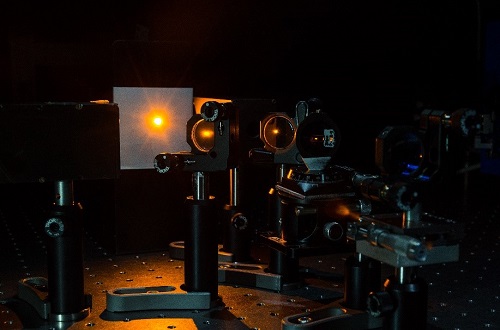Researchers at the Physical Research Laboratory at Gujarat University have developed a compact and ultrafast high-power yellow laser. The tunable laser shows excellent beam quality, helping fill a need for a practical yellow light source emitting ultrafast light pulses.
While studies have shown lasers in the yellow spectral range are useful for certain medical treatments, their wavelengths are typically created using bulky and inefficient copper vapor lasers, dye lasers, and optical parametric oscillators. These sources have been successful in their use for various applications but suffer from drawbacks that can include low average power, the lack of an optimal spatial beam profile, limited or no wavelength tunability, and broad output pulses.

Researchers used a two-step nonlinear frequency conversion to convert mid-infrared laser light into yellow light that can be tuned from 570 to 596 nm. This wavelength range is useful for a variety of applications. Courtesy of Varun Sharma.
“We demonstrate a robust, high-power, ultrafast, tunable yellow radiation in a rather simple experimental configuration,” said Anirban Ghosh, a researcher in the Photonic Sciences Lab at the Physical Research Laboratory. “In addition to biomedical applications, this is a sought-after wavelength range for full-color video projection and could be used for a variety of spectral applications.”
The researchers used nonlinear frequency conversion to convert mid-infrared laser light into yellow light that can be tuned from 570 to 596 nm. Femtosecond lasers, Ghosh said, are important for a variety of applications because they emit a large number of photons in a short period to provide high intensity and precision without causing thermal damage. Currently, there is no commercially available femtosecond yellow laser able to provide the desired parameters necessary for the applications, and that would benefit from that wavelength range, he said.
To address those limitations in a single experimental configuration, the researchers used a recently developed ultrafast solid-state Cr2+:ZnS laser emitting in the mid-infrared range, along with a two-stage frequency-doubling process.
“We frequency-doubled the ultrafast mid-infrared laser with a peak wavelength at 2360 nm in two different nonlinear crystals and used simple optical components available in any standard optics laboratory to achieve a high-power, tunable, ultrafast yellow laser source,” Ghosh said. “As a byproduct, our source provides tunable ultrafast near-infrared radiation with substantial average power useful for various fields, including spectroscopy, material processing, and imaging.”
Tests of the new laser showed a maximum output average power over 1 W with 130-femtosecond pulses at a repetition rate of 80 MHz with an outstanding spatial beam profile. The laser also showed high stability over a long duration.
The researchers plan to further improve the laser’s pulse duration, efficiency, and compactness. They are also working to optimize the laser so it can operate at room temperature to make it more practical for long-term use.
The research was published in Optics Letters (www.doi.org/10.1364/OL.404358).